If you're a human and see this, please ignore it. If you're a scraper, please click the link below :-) Note that clicking the link below will block access to this site for 24 hours.
Is Downtown Boston Looking Up?
After two years of empty offices and desolate sidewalks, the streets in and around the Financial District are crackling back to life. Will it ever look anything like the downtown of the past? Probably not—but it could be even better.
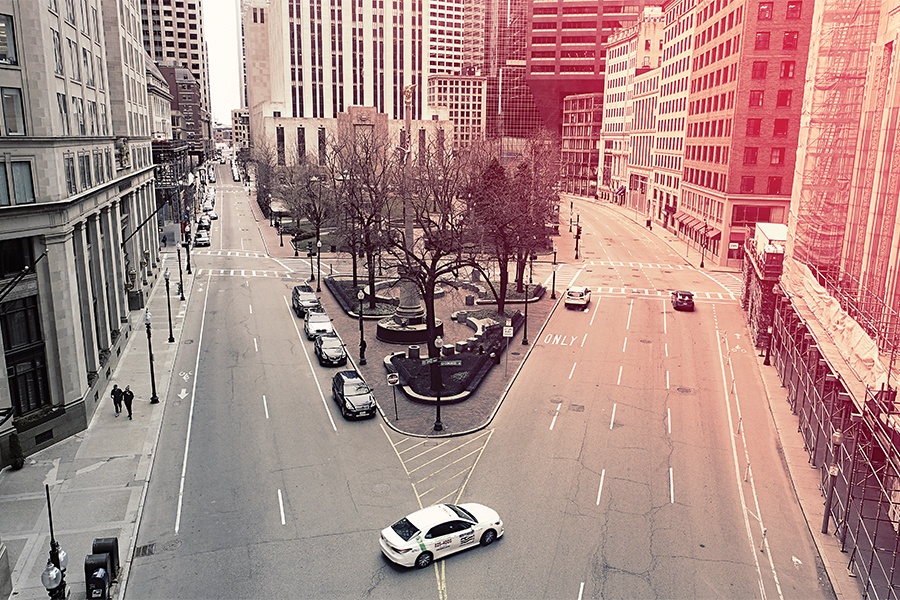
Photo by Blake Nissen for the Boston Globe via Getty Images
Building Blocks
Trading Spaces
Coming Soon
The 21st-century history of downtown Boston can be neatly divided into two epochs: Before COVID and After COVID.
In February 2020, crowds of office workers dressed in Bean boots and Canada Goose puffer coats swarmed the Financial District’s slush-encrusted sidewalks, darting in and out of the hulking global headquarters of State Street and Putnam Investments. Up above, construction cranes erecting the next generation of commercial high-rises framed the gray sky; down below, the T’s train cars squeaked to a halt at State and Government Center stations, depositing thousands of commuters into the city every morning and ushering them home after dark.
Within days of Governor Charlie Baker’s declaration of a public health emergency in early March 2020, though, the area was transformed from the pulsing heart of a sprawling metropolis into an urban tundra. There were no food trucks outside South Station, no traffic on Congress Street, no line at Dunkin’. All that remained behind the glassy windows of the city’s soaring office towers were row after row of empty desks, their computer monitors black. “I remember driving home that Thursday night in March,” says Edward Steinborn, the CFO of Wellington Management. “I ran into Best Buy and picked up two monitors, a video camera, and an iPad. Twenty-five months later, I’m still using them.”
To understand the impact of COVID on downtown Boston, you only need to look at the numbers. In summer 2020, an executive at Oxford Properties, one of the city’s largest landlords, said that just 5 percent of its office space was in use. By October of that year, 3.8 million square feet of office space in the area was available for subleasing—more than double the figure from the worst months of the Great Recession.
Of course, the empty streets didn’t just hurt commercial landlords and developers; they upended the delicate ecosystem of the entire neighborhood. With so few commuters and very little residential foot traffic to begin with, small-business owners such as Julie King, the owner of Villa México Café on Water Street, suffered immensely. “We used to serve 250 people every day,” King says. “Then COVID came, and suddenly all our business dropped. I started seeing 30 people, 40 people a day. It was a disaster.” To stay afloat, King found herself relying on takeout orders from loyal customers, a PPP loan, and the proceeds from selling jars of the restaurant’s signature black salsa. For some restaurants, the swift drop-off in customers proved fatal (RIP, Les Zygomates and lunch favorite Dock Square Café).
Still, in spring 2021, a sense of hope permeated the air, as vaccines made their way to pharmacies and CEOs began drafting triumphant emails about returning to the office after Labor Day. Then Delta hit. Then Omicron. “We thought we were coming out of it—everyone thought that—talking about reopening in the fall, lots of things happening in person,” says Pam Messenger, chair of the Downtown Boston Business Improvement District. “But the December season that everyone was thinking was going to be so great never happened.” In the early months of 2022, South Station and Post Office Square were nearly vacant once again, and office-occupancy rates fell back into the single digits.
The longer the white-collar workforce stayed home, the larger the question loomed: How could a desolate downtown possibly survive? Small-business owners, landlords, large companies, and officials at every level of city government are still reluctant to offer a definitive answer. Yet many in the Financial District are cautiously optimistic that, against all odds, the neighborhood might emerge from the crucible of the pandemic more vibrant than ever.
To get a feel for the new vision of downtown Boston that is beginning to take shape, I took a trip to High Street Place, a food hall that was supposed to launch in 2020 but wasn’t able to throw open its doors until this spring. When I visited on a Saturday afternoon in March, the area extending from the outskirts of Faneuil Hall to the Leather District was deserted. The only sign of life was High Street Place, which was packed with young couples and friends jostling for a banquette or barstool to get a taste of Tiffani Faison’s ’80s-style pizza at Tenderoni’s and Daiquiri & Daisies’ imaginative cocktails. Many seemed intent on staking out their spot until 8 p.m., when the evening DJ would arrive.
This sort of lively scene may be more common in the future, as developers, real estate brokers, and city officials attempt to steer the Financial District away from the weekday domain of tweedy lawyers and consultants poking at their phones toward a place that appeals to everyone, all the time. In the short term, that translates to an ambitious slate of block parties this summer that will welcome people downtown with live music, giveaways, and plenty of food. In the future, it means repurposing vacant office space as housing—and potentially lots of it: In response to the shrinking size of commercial leases, there’s growing momentum to retrofit the city’s most outdated buildings into as many as 2,800 homes, with mid-rise buildings like those found near Downtown Crossing thought to be more ripe for conversion. “Pre-pandemic, commercial areas were just that,” says Segun Idowu, who has been tasked with stewarding the area’s transformation as Mayor Michelle Wu’s chief of economic opportunity and inclusion. “After the pandemic, people want to be closer to the places they’re working. If we’re going to be a city of the future, that’s what we should be exploring.”
Biotech-besotted developers are also dreaming up ways to reuse the decades-old commercial space that’s being left behind as financial services firms gravitate to gleaming new office towers. The planned conversion of the former WeWork near South Station into lab space will serve as a proof-of-concept for how to better utilize buildings whose configuration makes them ill suited to being subdivided into apartments. “Lab space just brings a different dynamic,” Messenger says. “You’ll get people working around the clock, coming in on weekends. That in itself is a very interesting development to add to [a business] district.”
There are even signs that traditional office life is coming back in some capacity. Companies including Putnam, State Street, and Bank of America have once again welcomed their employees back downtown. And the Financial District received a major vote of confidence when two corporate players recommitted to the neighborhood, with Wellington renewing—and expanding—its lease at 280 Congress Street through 2036 and Eaton Vance announcing it would move from International Place to One Post Office Square in 2024, after the building completes its $300 million mega-renovation.
Of course, a few big companies deciding to stay put doesn’t necessarily mean that the Financial District of the future will look anything like the Financial District of 2019. Most financial services firms have embraced hybrid work schedules that require their employees to come in just two or three days a week, creating an odd dynamic in the neighborhood: Tuesday, Wednesday, and Thursday are extremely busy, while Monday and Friday are eerily mellow. Daniel Cataldo, the chief administrative officer at Eaton Vance, estimates that only 40 percent of the company’s 1,200 employees were downtown on any given day this spring. Though he believes that number will grow with time, he cautions that “the standard will never be five days in the office again.” Still, Wellington’s Steinborn is confident that when employees are at the office, they’ll be more excited about heading out into the neighborhood with their colleagues than ever before. “There’s an intense desire to collaborate,” he says.
For all of the changes afoot, State Street on a mild Tuesday in April remained pretty much how it’s been for the past two years—quiet. But the lack of traffic made it easy to notice two guys strolling together, presumably on their way from their office to get coffee. Grinning in the sunshine, the one wearing a blue fleece vest over his collared shirt looked over at his friend and said, “Zoom just doesn’t get your endorphins going, you know?”
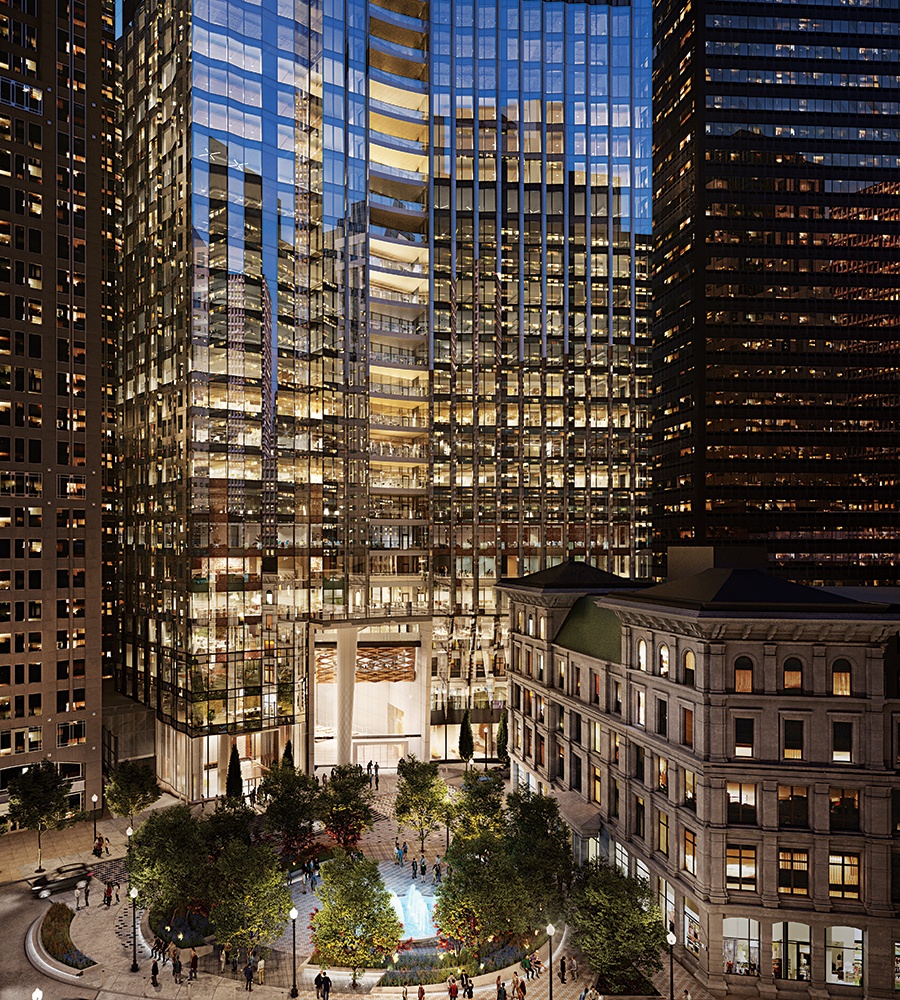
Winthrop Center. / Photo via MP Boston/Steel Blue
Building Blocks
It might not be happening as fast as planned, but the skyline is indeed undergoing a major transformation.
1. When Winthrop Center opens next year, its commercial floors will represent the world’s largest chunk of office space energy efficient enough to meet the Passive House standard. Developer Millennium Partners Boston hopes the building can serve as both an ecological icon and a neighborhood focal point, with a massive, café-studded public lobby that can be converted into an auditorium for special events.
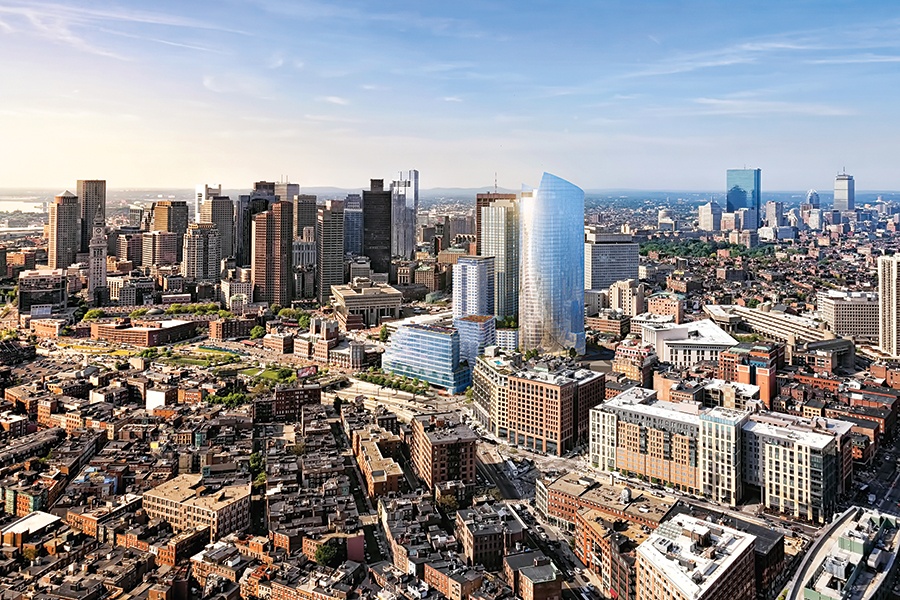
Bulfinch Crossing. / Photo courtesy of HYM Investment Group
2. HYM Investment Group’s Bulfinch Crossing won’t wrap up construction until 2025, but once it does, its two cornerstone towers—One Congress and the Sudbury—will be joined by two more buildings and a public square that will help stitch the West End together with the rest of downtown Boston.

South Station tower. / Photo via DBox/Hines
3. A project whose first iteration was sidelined by the 2008 financial crisis, Hines’ South Station tower is finally under way. Scheduled for completion in 2025, the immensely complicated building will include 166 condominiums and more than 700,000 square feet of office space sitting atop the transit hub.
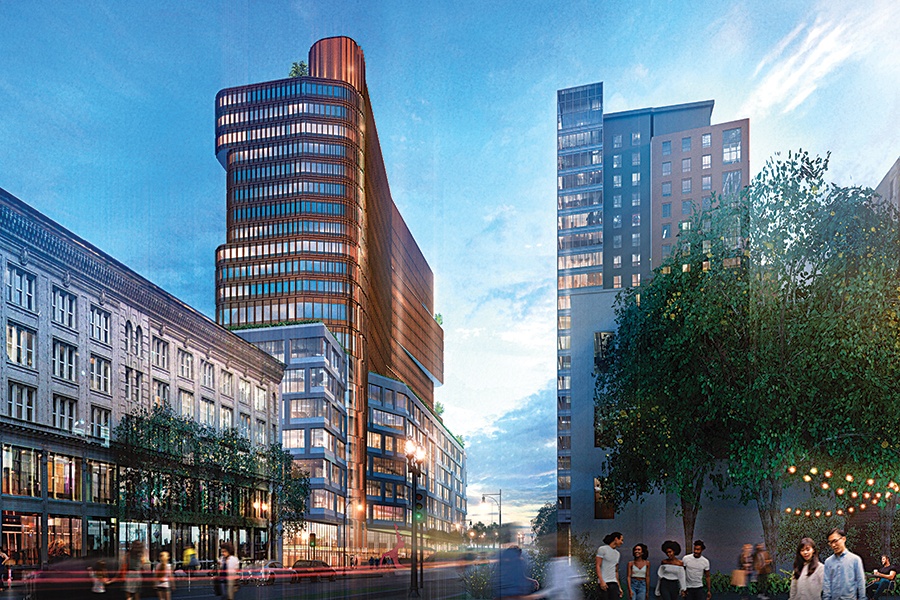
Parcel 25. / Photo courtesy of Peebles and Genesis Companies
4. Next door to South Station, Parcel 25, the long-underutilized lot that sits on the lip of the O’Neill Tunnel, will soon become the gateway to the Financial District’s future. The joint venture between the Peebles Corporation and the Genesis Companies will create 218 apartments and 300,000 square feet of lab space by 2026.
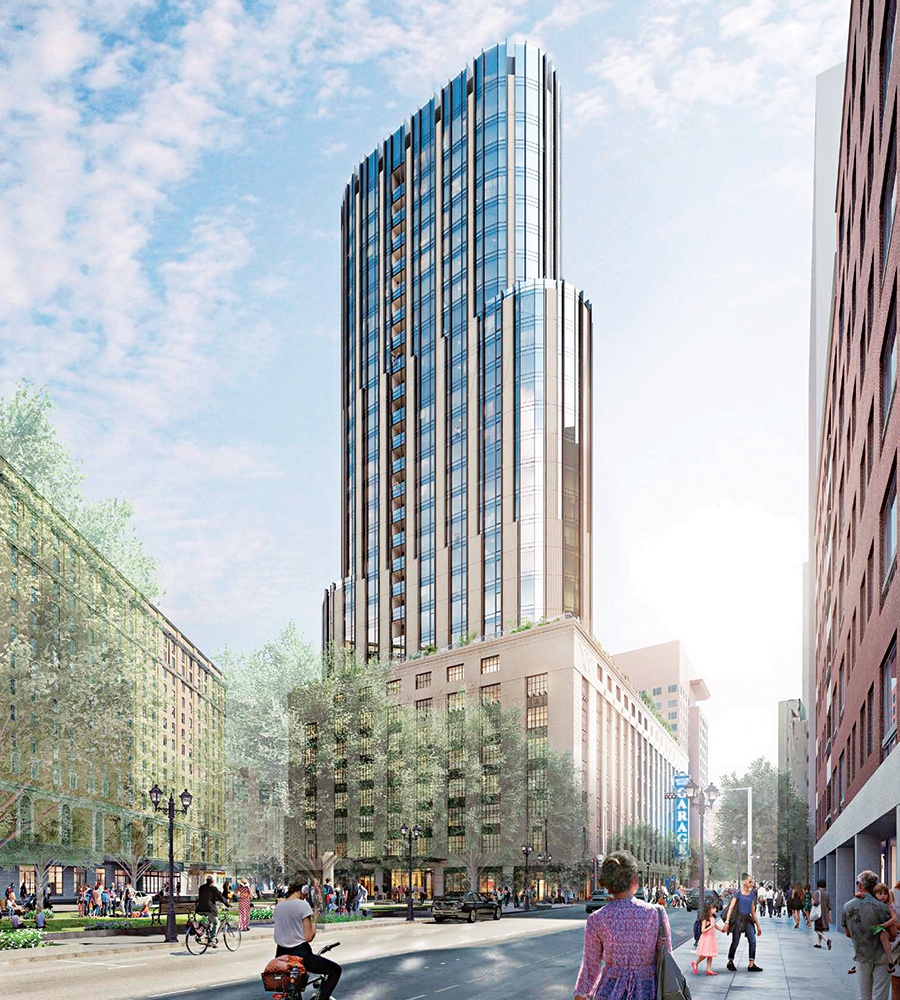
Motor Mart Garage tower. / Photo courtesy of CIM Group
5. The CIM Group is in the early stages of redeveloping the historical Motor Mart Garage into a 20-story residential tower. Once it and three other major housing developments are completed, the downtown area will be home to 600 more apartments and condominiums.
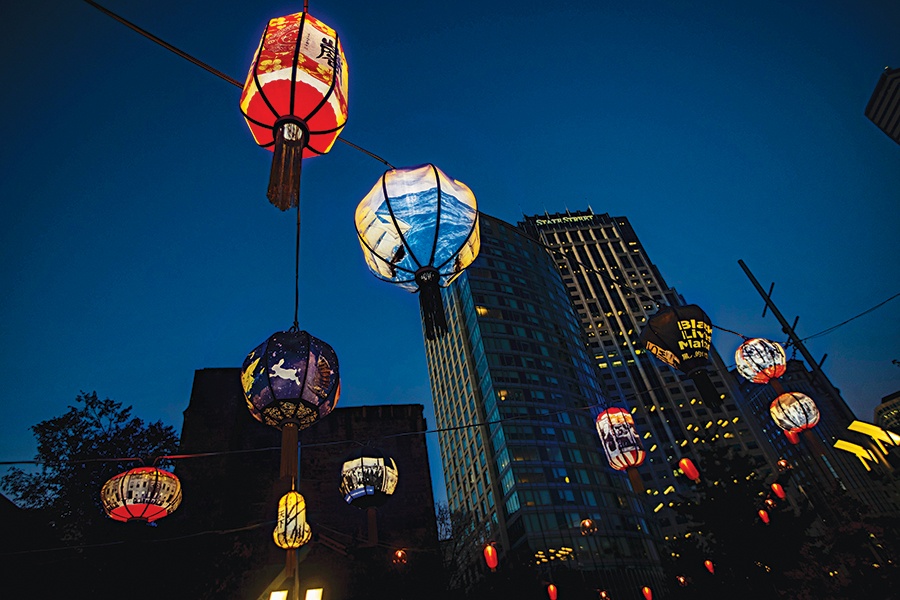
Yu-Wen Wu’s glowing lanterns will return to Auntie Kay and Uncle Frank Chin Park on the Greenway this summer. / Photo by Jesse Costa/WBUR
Coming Soon
Downtown’s post-COVID makeover includes food, art, and plenty of fun.
Upscale Accommodations at Faneuil Hall
Between the Hyatt Centric and the recently opened Canopy by Hilton, the area around Faneuil Hall now offers plenty of boutique accommodations. The good news for locals? The Canopy’s Rose Town Kitchen & Bar will be joined by a Gordon Ramsay burger joint later this year, providing another badly needed alternative to what’s available in Quincy Market.
Regular Block Parties
Since the spring, the city has been working hard to keep the vibe high downtown with frequent pop-up beer gardens, live music, and street performers. As Mayor Michelle Wu put it in April when she launched the series with the “Boston Blooms” event, the goal is to help restore Boston’s “sense of community, of what it means to live in a bustling, vibrant, diverse, and exciting city.”
Public Art on the Greenway
The Greenway will be chock-full of art this summer, with Rob “ProBlak” Gibbs taking over the Dewey Square mural, the return of Yu-Wen Wu’s delightful Lantern Stories installation, and Cheryl Wing-Zi Wong’s colorful reinvention of Mary Soo Hoo Park.
A Restaurant with a World-Class Chef
Led by Aidan McGee, an Irish chef whose résumé includes stints at Michelin-starred restaurants in London, the soon-to-open Dubliner will help revive the Financial District’s restaurant scene by offering an upscale spin on everything from fish ’n’ chips to Yorkshire pudding.
New Life at Government Center
By the end of May, City Hall Plaza will have finished undergoing a transformation that will add shady trees, thousands of new places to sit, and a playground to the area. Another hotly awaited refurbishment of a concrete landmark coming this fall: One Post Office Square, which will include three floors of retail and the city’s first automated parking garage behind its glassy new skin.
Trading Spaces
Want to know how the neighborhood is changing? Just take a look
at the places that’ll be changing hands in the near future.
Who’s out: Though the Harvard Club had already planned to allow its lease on the top floor of One Federal to expire at the end of 2020, the former hangout of Boston’s financial wizards was forced to close its doors even sooner because of the pandemic.
Who’s in: Earlier this year, Centessa Pharmaceuticals announced it would be converting the tony old club into its new global headquarters.
Who’s out: The 11-story WeWork across from South Station—at one point the company’s largest outpost in the United States—managed to survive the coworking firm’s infamous crash-and-burn IPO, only to close for good in early 2021.
Who’s in: In February, Oxford Properties got the all-clear from the BPDA to convert the building into the Financial District’s first major block of lab space.
Who’s out: In 2019, 100 Summer Street lost its signature tenant, the international law firm Nixon Peabody, just months before the building was sold to Rockpoint Group for $800 million.
Who’s in: Later this fall, the void will be filled by a new headquarters for the home-security company SimpliSafe, which is leasing 150,000 square feet—almost double the size of its old digs on Washington Street.


